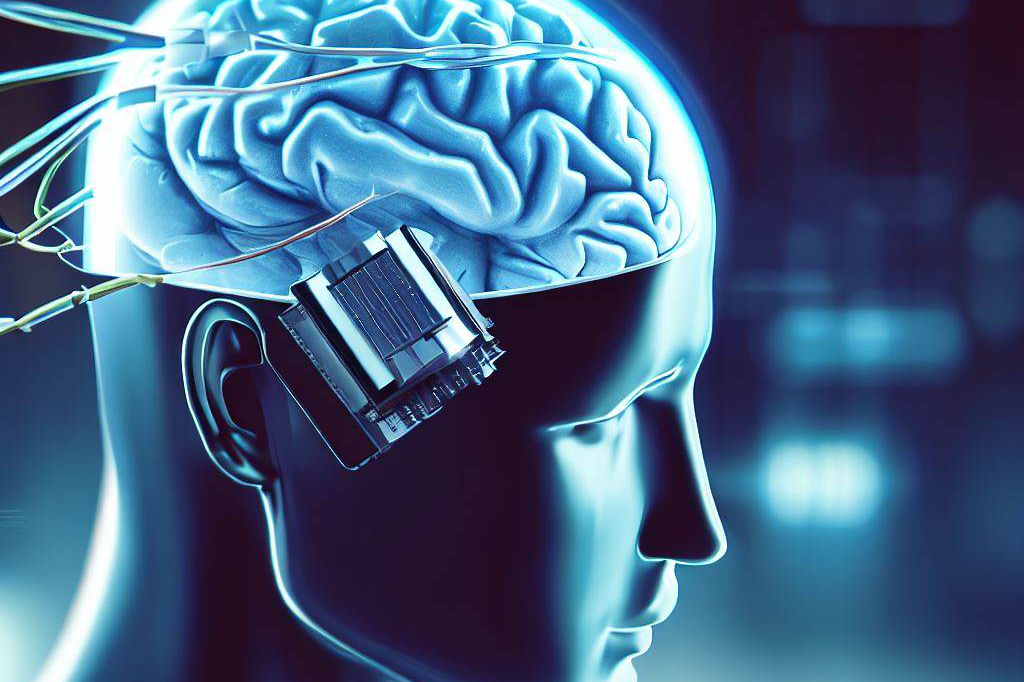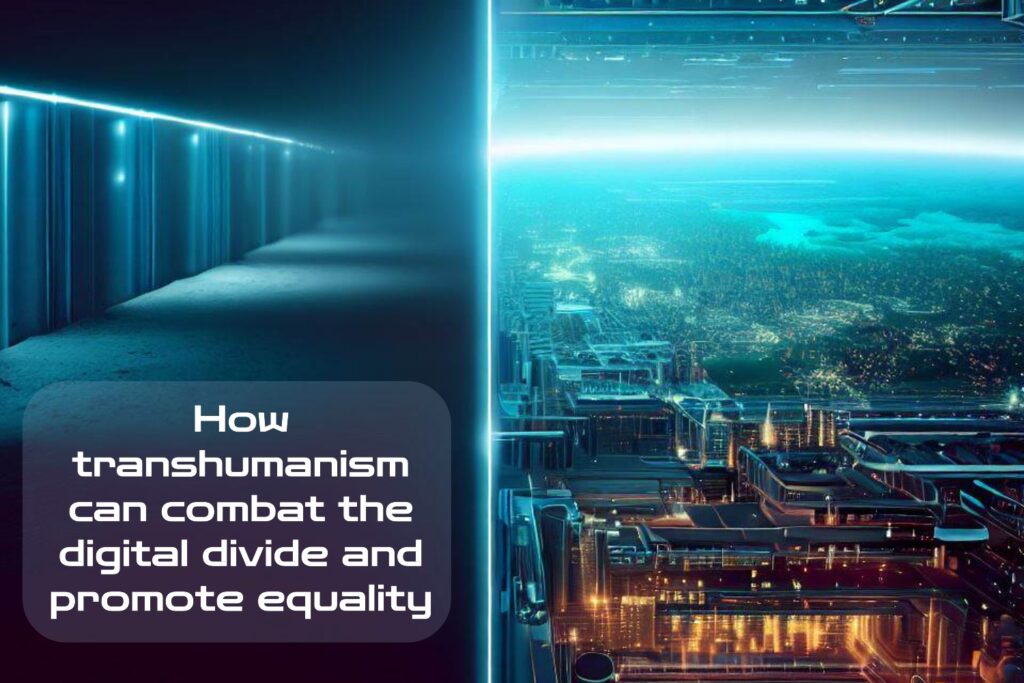The Transhumanist Movement Defined
Transhumanism is a movement that seeks to enhance human abilities through technology. This can range from small-scale enhancements such as wearable technology or smart drugs to more radical forms of enhancement such as brain implants or genetic engineering.

The ultimate goal of transhumanism is to create a society of post-human beings who possess greater intelligence, longevity, and overall well-being than current humans. The notion of transhumanism is not new.
In fact, it can be traced back to ancient myths and legends about immortality and superhuman abilities. However, the modern transhumanist movement emerged in the late 20th century with the advent of advanced scientific technologies such as biotechnology and artificial intelligence.
The Digital Divide Explained
The term “digital divide” refers to the gap between those who have access to digital technologies (such as computers, smartphones, and the internet) and those who do not. This gap exists on both a global scale (between developed and developing countries) and within individual countries (between affluent and disadvantaged communities). The consequences of the digital divide are far-reaching.
Those without access to technology are often excluded from educational opportunities, job training programs, healthcare resources, political participation, social networks, and other benefits that come with being connected online. This lack of access can perpetuate existing inequalities based on race, gender identity or expression, socioeconomic status, geographic location, or disability.
The Potential Impact on Equality

Despite its complexities regarding ethics and social implications for humanity’s future existence itself – transhumanism has been regarded by many theorists as a solution that could bridge this gap by providing marginalized communities with greater access to essential resources through technological enhancements. Transhumanist technologies can potentially improve education by providing online classes accessible through neural implants or portable devices, providing equal opportunities to those who previously would have been excluded due to geographic location or disability. It can also improve healthcare, for example, by using sensors and neural implants to monitor an individual’s health and notify healthcare professionals in real-time, making care more accessible and cost-effective.
Additionally, transhumanism might offer crucial resources that could help people with disabilities overcome barriers. One example is the use of exoskeletons for individuals with mobility impairments, which can make it easier for them to navigate their environment.
The relationship between transhumanism and the digital divide is complex. While some skeptics argue that it may exacerbate inequalities by creating a new class of “superhumans,” there is potential for transhumanist technologies to bridge the gap between those who have access to technology and those who do not, creating a more equal society.
The Digital Divide and Its Consequences
Access to Technology and Information: A Brief Explanation of the Digital Divide
The digital divide refers to the difference in access to technology and information between different groups of people. This divide has been growing larger as technology advances at an increasingly rapid pace, leading to a situation where some individuals or communities have access to cutting-edge technologies while others have no access at all. One of the main causes of this divide is economic inequality.
Those with more resources are able to purchase computers, smartphones, high-speed internet, and other gadgets that enable them to access vast amounts of information, conduct online transactions, and participate in online social networks. Conversely, those without the resources must rely on libraries or other public facilities for internet access or go without.
Perpetuation of Inequality Through Education, Employment, Healthcare, and Other Areas

The impact of the digital divide extends far beyond simple access differences. It also perpetuates inequality in areas such as education, employment opportunities, healthcare access, and outcomes.
In education, for example — students who do not have regular internet connectivity at home may fall behind their peers academically as they are unable to keep up with online coursework or research assignments. This gap could further widen during periods such as COVID-19 related remote learning, where regular internet connectivity became an essential part of learning.
Similarly, in employment opportunities – those who lack basic computer literacy skills may find themselves struggling to compete in today’s job market – jobs that require computer proficiency become unavailable due to a lack of skillsets, which keeps them from progressing in their career paths.
Marginalized Communities and the Digital Divide
Marginalized communities, including people of color, low-income households, those in rural areas, and individuals with disabilities, are disproportionately affected by the digital divide. These communities often lack the resources needed to access information or acquire technology skills and equipment. For example, a 2019 report from the Pew Research Center found that 35% of adults with household incomes below $30,000 per year do not own a smartphone, compared to only 6% of those with household incomes above $75,000 per year.
In addition to economic factors – other barriers that marginalized groups face include limited access to training on technology use, computer applications and inadequate IT infrastructure in rural areas or poor urban neighborhoods. All of these factors compound to create significant disparities in digital literacy levels between different communities – this further exacerbates existing inequalities and prevents equal participation in today’s society, where many interactions happen digitally.
Transhumanism: A Solution to the Digital Divide?
Explanation of Transhumanism as a Movement that Seeks to Enhance Human Abilities through Technology

Transhumanism is a philosophical movement that advocates for the use of technology to enhance human abilities beyond what is currently possible. It emerged in the 1980s and has gained traction over the years as technological advancements continue to push the boundaries of what it means to be human. The movement aims to improve human life by expanding cognitive, physical, and emotional capacities through technological interventions.
Transhumanist technologies include brain-computer interfaces, prosthetics, gene editing, and nanotechnology.
Brain-computer interfaces allow humans to interact directly with machines using their brainwaves while prosthetics can replace lost limbs or augment existing ones.
Gene editing allows for genetic modification at the cellular level, while nanotechnology can be used for targeted drug delivery or tissue engineering.
These technologies have the potential to revolutionize how humans interact with their environment and each other.
How Transhumanist Technologies Can Potentially Bridge The Gap Between Those Who Have Access To Technology And Those Who Do Not
The Digital Divide is a significant barrier that prevents marginalized communities from accessing technology and information. However, transhumanist technologies have the potential to bridge this gap by providing marginalized communities with access to cutting-edge tools that could level the playing field in education, healthcare, and employment opportunities.
For example, brain-computer interfaces could provide remote access to education or job training programs for individuals who live in areas without adequate infrastructure or funds for classroom education.
Prosthetics can empower individuals who have suffered limb loss due to disease or war by providing them with mobility options that were previously unavailable.
Gene editing could eradicate certain diseases that disproportionately affect marginalized communities such as sickle cell anemia or cystic fibrosis.
Examples Of How Transhumanist Technologies Can Improve Education, Healthcare, And Employment Opportunities For Marginalized Communities
Transhumanist technologies have the potential to improve various aspects of marginalized communities’ lives. In terms of education, technologies like augmented reality and virtual reality can provide immersive learning environments that are accessible from anywhere in the world. This could allow students who live in areas without adequate infrastructure to access high-quality education programs.
In terms of healthcare, gene editing could provide solutions for incurable diseases that disproportionately affect marginalized communities, while nanotechnology could be used for targeted drug delivery or tissue engineering. These technological interventions could enable equitable access to healthcare services and allow individuals to receive quality care regardless of their geographic location.
In terms of employment opportunities, prosthetics and brain-computer interfaces can empower individuals with disabilities by providing them with tools that allow them to perform tasks they were previously unable to do. This could create new job opportunities and unlock previously untapped potential in marginalized communities.
Overall, transhumanist technologies have the potential to bridge the Digital Divide and create a more equal society by providing marginalized communities with access to cutting-edge tools that could level the playing field in education, healthcare, and employment opportunities. However, it is important to address ethical concerns surrounding these technologies before implementation so as not to perpetuate existing inequalities.
Ethical Concerns with Transhumanism
Exploring the Ethical Concerns Surrounding Transhumanist Technologies
While transhumanist technologies offer a range of potential benefits, they also raise significant ethical concerns. One such concern is the possibility that these technologies will exacerbate existing inequalities, particularly those related to access to healthcare and education. For instance, if only the wealthy can afford enhancements like genetic engineering or brain implants, it could lead to a widening gap between the haves and have-nots.
Additionally, some critics argue that transhumanist technologies could be used for nefarious purposes like eugenics or creating “super soldiers” for military purposes.
Another ethical concern is related to safety. Many transhumanist technologies are still in development or experimental stages, and it’s unclear what long-term effects these enhancements may have on human health and wellbeing. There is also the risk that individuals who undergo extreme enhancements may become overly reliant on technology or lose sight of their own humanity.
Do Ethical Concerns Outweigh Potential Benefits for Marginalized Communities?
Despite these concerns, there are compelling arguments in favor of transhumanism as a means to promote equality among marginalized communities. By providing access to advanced medical treatments or cognitive enhancements like brain-computer interfaces (BCIs), transhumanism has the potential to level the playing field for individuals who have been historically disadvantaged by systemic inequality.
Moreover, many advocates point out that ethical concerns surrounding new technologies are not unique to transhumanism but rather part of a broader debate about how society should approach innovation and progress. They argue that advancements in technology can be harnessed for good if we establish robust regulatory frameworks and invest in responsible research and development.
Exploring Ways to Address Ethical Concerns While Still Advancing Transhumanism
To address ethical issues surrounding transhumanism, it’s important to engage in open dialogue and debate about the risks and benefits of these technologies. This includes involving diverse stakeholders in discussions around research and development, from affected communities to ethicists and policymakers.
Another strategy is to invest in transparency and accountability measures. This could include developing clear guidelines for research and experimentation, as well as ensuring that individuals who undergo transhumanist enhancements are fully informed about potential risks and side effects.
Ultimately, there is no one-size-fits-all solution to the ethical concerns surrounding transhumanism. However, by approaching these issues with an open mind and a commitment to social justice, we can ensure that advancements in technology benefit all members of society.
Final Thoughts
While the ethical concerns surrounding transhumanism are valid and should not be dismissed lightly, it’s important not to lose sight of the potential benefits these technologies can offer. By promoting equality among marginalized communities through advanced medical treatments or cognitive enhancements like BCIs, we have the opportunity to create a more just society where everyone has access to the tools they need to thrive.
As we move forward with research and development in this field, it’s crucial that we do so with a sense of responsibility towards individuals who may not have access to these technologies otherwise. By investing in transparency measures and creating ethical guidelines for experimentation, we can ensure that advancements in technology serve the common good rather than perpetuate existing inequalities.
FAQs
1. What is transhumanism?
Transhumanism is a movement that seeks to enhance human abilities through technology, ranging from wearable devices to brain implants and genetic engineering. The goal is to create post-human beings with greater intelligence, longevity, and overall well-being.
2. What is the digital divide?
The digital divide refers to the gap between those who have access to digital technologies (computers, smartphones, internet) and those who do not. It exists both globally, between developed and developing countries, and within individual countries, between affluent and disadvantaged communities.
3. How does the digital divide impact equality?
The digital divide perpetuates existing inequalities based on race, gender identity, socioeconomic status, geographic location, or disability. Those without access to technology are excluded from educational opportunities, job training programs, healthcare resources, and other benefits of being connected online.
4. Can transhumanism bridge the digital divide?
Transhumanism has the potential to bridge the digital divide by providing marginalized communities with greater access to essential resources through technological enhancements. For example, online classes accessible through neural implants or portable devices can improve education opportunities for those previously excluded due to location or disability.
5. How can transhumanist technologies improve healthcare for marginalized communities?
Transhumanist technologies, such as sensors and neural implants, can monitor an individual’s health and notify healthcare professionals in real-time, making care more accessible and cost-effective. Exoskeletons can help individuals with mobility impairments navigate their environment, overcoming barriers they face.
6. How does the digital divide perpetuate inequality in education, employment, and healthcare?
Lack of access to technology hinders educational progress, as students without internet connectivity fall behind academically. It also limits employment opportunities for those without computer literacy skills, preventing career advancement. In healthcare, the divide denies equal access to information and quality care, perpetuating health disparities.
7. Which communities are disproportionately affected by the digital divide?
Marginalized communities, including people of color, low-income households, those in rural areas, and individuals with disabilities, are disproportionately affected by the digital divide. Limited resources, inadequate IT infrastructure, and lack of training contribute to significant disparities in digital literacy levels.
8. How can transhumanist technologies improve education for marginalized communities?
Transhumanist technologies like augmented reality and virtual reality can provide immersive learning environments accessible from anywhere, bridging the gap in educational opportunities. Students in areas without infrastructure can access high-quality education programs through these technologies.
9. How can transhumanist technologies improve healthcare for marginalized communities?
Gene editing can provide solutions for diseases that disproportionately affect marginalized communities, while nanotechnology enables targeted drug delivery or tissue engineering. These interventions ensure equitable access to healthcare services, regardless of geographic location.
10. What ethical concerns are associated with transhumanism?
Ethical concerns surrounding transhumanism include potential exacerbation of existing inequalities, misuse of technologies for eugenics or military purposes, and uncertainties regarding long-term health effects and human reliance on technology.
11. Do ethical concerns outweigh the potential benefits for marginalized communities?
While ethical concerns are valid, transhumanism has the potential to promote equality among marginalized communities by providing access to advanced medical treatments and cognitive enhancements. Responsible research, development, and regulatory frameworks can address ethical issues effectively.
12. How can ethical concerns surrounding transhumanism be addressed?
Open dialogue involving diverse stakeholders is crucial to discuss the risks and benefits of transhumanist technologies. Transparency measures, guidelines for research and experimentation, and informed consent for individuals undergoing enhancements can help address ethical concerns responsibly.
TL;DR…
– 💡 Transhumanism is a movement that aims to enhance human abilities through technology, from wearable devices to brain implants and genetic engineering.
– 💻 The digital divide refers to the gap between those who have access to digital technologies (computers, smartphones, internet) and those who do not, perpetuating inequalities based on race, socioeconomic status, and more.
– 🌍 Transhumanist technologies have the potential to bridge the digital divide by providing marginalized communities with access to cutting-edge tools in education, healthcare, and employment opportunities.
– 🏫 Transhumanist technologies can improve education by offering online classes accessible through neural implants or portable devices, providing equal opportunities to those previously excluded.
– 🏥 In healthcare, transhumanist technologies such as sensors and neural implants can monitor health in real-time, making care more accessible and cost-effective.
– 🌐 The digital divide hinders equal participation in society, particularly for marginalized communities, including people of color, low-income households, rural areas, and individuals with disabilities.
– 🔍 Limited access to technology, lack of training, and economic factors compound the disparities in digital literacy levels between different communities, further perpetuating inequalities.
– 👥 Transhumanism has the potential to level the playing field for marginalized communities, empowering individuals through advancements like brain-computer interfaces, prosthetics, and gene editing.
– ⚖️ Ethical concerns surrounding transhumanism include exacerbating inequalities, misuse of technologies, and uncertainties about long-term health effects and human reliance on technology.
– 🌱 Responsible research, open dialogue, transparency, and informed consent are crucial in addressing ethical concerns while advancing transhumanism for the benefit of all.

C M, a seasoned editor, journalist, and consultant, is deeply fascinated by the convergence of technology, space, and the future of humanity.
With a particular interest in transhumanism, futurology, and the philosophical and ethical dimensions of these domains, C M serves as the lead contributor to TranscendSphere and SpaceSpotlight.
When not penning insightful articles on these rapidly evolving fields, C M indulges in their love for podcasts and books, proudly embracing their status as a ‘Happy Nerd Extraordinaire!’





